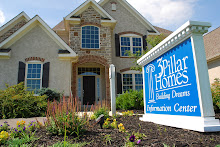Does it seem to you that new homes are generally bigger than older ones? If so, your observation is correct. The average new home today is nearly 500 square feet (or 25%) larger than the average house built 20 years ago, and 12% larger than those built in the late 1990s.
However, mere square footage is not the primary reason why new homes are more spacious than their predecessors.
Homes are now designed to enhance the perception of larger space and to allow a variety of functions in the common areas of the home. Open floor plans, increasingly popular across all housing types, sizes and prices, create long views through the home and afford "shared" spaces that serve multiple needs.
The perfect example of this concept is the combination kitchen-eating nook-family room. An uninterrupted view from either end makes this space appear quite large as each "area" spills easily into the next. A kitchen island extended into the eating area, for instance, may serve as the family's everyday dining area, homework or bill-paying center, or craft counter. In turn, that area transitions seamlessly into the family room where family members and guests can relax but stay in touch with activity and conversations in the kitchen -- where the cook used to be isolated!
This perceived space is made even greater by a row of windows along the long wall of the room looking into the back yard. More windows may be located on the kitchen and/or family room end-walls.
These windows extend the long interior view even further to the exterior of the house, giving the illusion of more space inside. Extensive daylight -- especially from three walls -- also creates a more comfortable and energy efficient living space.
The benefits of the open plan kitchen-eating nook-family room are now being extended to include other rooms on the main floor of the house. Passageways from the living room and formal dining rooms to the more informal areas of the house are uninterrupted by doors to maintain the shared usage and long sightlines that create the feeling of spaciousness.
The open plan concept is taken to its extreme in floor plans that eliminate the distinction between living room and family room to create a "great room" that is entirely open to other areas of the house. Another variant, the loft-style house (born out of urban industrial warehouse space adapted to residential use) offers an open floor plan that is completely flexible in its use -- and therefore appears to be the most spacious option of all.
Other design features that enhance perceived or actual space in new homes include the use of higher ceilings -- most effective in large rooms where good proportion can be maintained -- and greater access to usable outdoor living areas. Patios, decks and balconies fitted with furnishings, cooking and eating areas, pools and spas, and lounge areas with flat-screen TVs and fireplaces are a more recent and popular innovation in new homes that actually boosts a home's practical footprint.
In summary, it is clear that design trends in new homes offer greater space and lifestyle flexibility. Existing homes, even those from a decade ago, cannot match the spacious look and feel of new homes.
skip to main |
skip to sidebar
We are a new home builder offering custom home plans to meet your lifestyle and budget. Whether you are in the market for a new, semi custom or custom home, we can help you achieve your dream.
3 Pillar Homes
5710 Delano Ave
Lewis Center, OH 43035
(740) 548-8599




